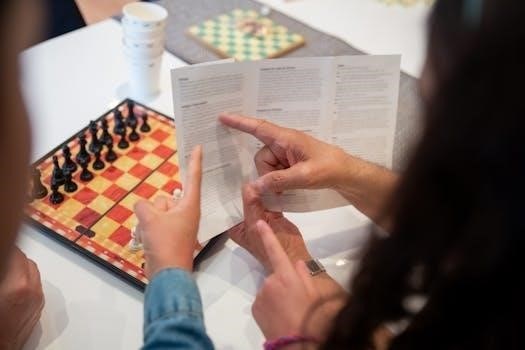Rack-O is a classic card game, dating back to the 1950s, that challenges players to arrange their cards in numerical order. This retro game, published by various companies, is enjoyed by families for its simple yet strategic gameplay.
Brief Overview of Rack-O
Rack-O is a sequential-matching card game where the goal is to be the first player to arrange ten cards in numerical order in your rack. Players draw and discard cards, strategically replacing them in their rack to achieve a low-to-high sequence. The game, suitable for 2-4 players, involves a combination of luck and tactical decision-making. It is a family-friendly pastime, enjoyed for its quick rounds and engaging gameplay. The game has been around for decades, and the timeless appeal of Rack-O continues to entertain players of all ages. Rack-O is a game where players must be both strategic and lucky.

Game Components and Setup
A standard Rack-O game includes a deck of 60 cards, four plastic racks for holding cards, and a rulebook. Setup involves shuffling the cards and dealing ten to each player.
What’s Included in the Box
Inside a Rack-O game box, you’ll typically find a deck of 60 uniquely numbered cards, ranging from 1 to 60. These cards are the core of the game, featuring bold, easy-to-read numbers that are suitable for players of all ages. Additionally, the box contains four plastic card racks, designed to hold ten cards each. These racks keep the cards organized and hidden from other players. Finally, a rulebook is included, providing the official instructions for gameplay, scoring, and any variations. This rulebook ensures that everyone understands how to play correctly.
Initial Setup for a Game
To begin a game of Rack-O, the first step is to shuffle the deck of 60 cards thoroughly. After shuffling, each player is dealt ten cards, which they place face down in their respective plastic racks. It is important that these cards are placed randomly in the rack, starting from the slot marked “10” and moving towards the slot marked “1”. Players should not look at their cards during this process, as the initial card placement is a crucial element of the game. The remaining cards form the draw pile, placed face down in the center of the playing area.

Objective of Rack-O
The primary goal in Rack-O is to be the first player to arrange all ten cards in your rack in ascending numerical order, from the lowest number at the front to the highest at the back.
Primary Goal of the Game
The central objective of Rack-O revolves around strategically organizing the cards within your designated rack. Players aim to achieve a specific numerical sequence, arranging their ten cards in ascending order, progressing from the smallest value at the front of the rack to the largest at the back. This requires careful consideration of each draw and discard, as players navigate through the deck, seeking the precise cards needed to complete their sequential arrangement. The first player to successfully achieve this ordered rack declares “Rack-O” and wins the round.
Gameplay Mechanics
Players draw cards from either the draw pile or discard pile, strategically replacing cards in their rack to create a numerical sequence. This draw and discard process is crucial for arranging cards.
Drawing and Discarding Cards
Each player, on their turn, begins by drawing one card from either the top of the face-down draw pile or the top of the face-up discard pile. After drawing, they must then choose one of their cards in their rack to discard, placing it face-up on the discard pile. This decision to draw from either pile or which card to discard is a key strategic element. Players are constantly evaluating their current rack and deciding which card to replace in the attempt to create an ascending numerical sequence. The process of drawing and discarding continues until a player is able to achieve ‘Rack-O’.
Arranging Cards in the Rack
The core objective of Rack-O is to arrange the ten cards in your personal rack into ascending numerical order, from lowest to highest, progressing from the front to the back. This is accomplished by strategically drawing and discarding cards. After drawing a card, a player chooses which of their existing cards, if any, to replace, placing the discarded card face-up on the discard pile. Players constantly rearrange their cards within the rack, utilizing the numbered slots as their guide. The goal is to gradually move the cards into their correct numerical sequence, which is key to achieving a ‘Rack-O’.

Winning the Round
A player wins a round by achieving “Rack-O”, which means successfully arranging all ten cards in their rack in ascending numerical order from front to back.
Declaring “Rack-O”
The moment a player successfully orders their ten cards in ascending numerical sequence within their rack, they shout “Rack-O!” to declare their victory for the round. This declaration should be made immediately, before drawing any more cards. Upon this declaration, the round concludes, and the scoring process begins. The player who declares “Rack-O” is the only person to receive points for that round. Remember that some variations add certain conditions or requirements to calling Rack-O in order to encourage more gameplay or strategy. If those conditions aren’t met, a player may not be able to declare “Rack-O”.
Scoring
The scoring system in Rack-O involves awarding points to the player who successfully declares “Rack-O”. Points are also often awarded for sequential runs within a player’s rack, leading to bonus points.
Standard Scoring System
In the standard Rack-O scoring system, the player who first achieves “Rack-O” by arranging their cards in ascending order typically receives 75 points. Other players then score five points for each card in their rack that is already in numerical sequence from the lowest to the highest positions. It is important to note that some scoring is done using a separate piece of paper, or a custom system may be used instead of the rule book’s system. The first to reach a certain total score, such as 500 points, wins.
Bonus Points for Runs
In addition to the standard scoring, Rack-O offers bonus points for creating runs, or sequences, of cards within your rack. These runs must consist of three or more cards in consecutive numerical order. A player can earn extra bonus points for these runs before declaring “Rack-O”. Bonus points for runs can range from 50 to 400 points, depending on the length of the sequence. This adds a challenging element of strategy to the game, as players can choose to risk their final “Rack-O” to gain more points.

Variations and Special Rules
Rack-O offers several variations to its standard gameplay, such as a two-player variant where a “Rack-O” requires at least three cards in consecutive order, and team play for four players.
Two-Player Variant
When playing Rack-O with only two players, a specific rule variation is often implemented to increase the challenge and strategic depth. In this two-player version, a player cannot declare “Rack-O” unless they have a minimum of three cards arranged in consecutive numerical order within their rack. This rule forces players to not only focus on getting their cards in ascending order but also to be mindful of creating runs, thereby adding an extra layer of planning. This variation prevents early, easy wins and encourages more tactical card play.
Team Play (Partners)
In Rack-O, when four players participate, the game can be played in teams of two, adding a collaborative element to the gameplay. Partners sit opposite each other, and their scores are combined at the end of each round. The first partnership to accumulate 500 points wins the game. This variation encourages communication and strategic planning between partners, as they must consider not only their own rack but also how their actions can benefit their teammate. Team play in Rack-O offers a dynamic and engaging experience.
Quick Game Rules
For a quicker and more simplified version of Rack-O, especially suitable for beginners or younger players, you can play just a single round without keeping score. In this variation, the first player to successfully arrange their cards in ascending numerical order and call “Rack-O” is declared the winner of the game. This quick play option eliminates the need for scorekeeping, making it a faster and easier way to enjoy the core mechanics of the game. It’s a great way to introduce Rack-O.
Rack-O Jr.
Rack-O Jr. is a version designed for younger players. The objective is to be the first to fill your rack with cards in ascending order, starting with the lowest number.
Differences from the Classic Game
Rack-O Jr. differs from the classic version primarily in its simplicity and the number of cards used. Rack-O Jr. typically has a smaller deck with numbers ranging from 1 to 54; The goal remains arranging cards in ascending order, but the game is designed for a shorter play time. The rules are streamlined, making it easier for younger players to grasp, and there are no bonus points for runs or complicated scoring systems, emphasizing basic sequencing skills. Also, the card racks are often smaller, accommodating fewer cards, and sometimes they are double sided with different colors.
Strategies and Tips
Strategic discarding is key; try to keep cards that can be used in numerical order; Peeking at the draw pile can help inform decisions. Consider freezing your rack to protect progress.
Tips for Improving Your Play
Focus on creating numerical sequences early on, even if they are not perfectly in ascending order. Pay close attention to the discarded cards; this can provide clues about what numbers are still in play. Don’t be afraid to discard a card that seems good if it hinders your overall sequence. Be mindful of what cards other players discard; this can hint at their rack’s structure. Also, consider the bonus points for runs in your rack and plan accordingly for the bonus rack-o. Strategic use of draw pile knowledge will help to complete your rack more efficiently.
Rack-O remains a beloved card game due to its timeless appeal and simple rules. Its blend of luck and strategy makes it enjoyable for players of all ages, ensuring its continued popularity.
Rack-O’s Enduring Appeal
Rack-O’s enduring appeal stems from its simplicity and engaging gameplay, captivating players for decades. The game, with its roots in the 1950s, has a nostalgic charm that resonates with families. The objective of arranging cards in numerical order is easy to grasp, yet the strategic element of drawing and discarding adds depth. This combination makes it accessible to all ages, while still offering a satisfying challenge. Its lasting popularity is a testament to its ability to provide timeless fun and entertainment. Rack-O truly is a classic game that continues to bring joy to players.


